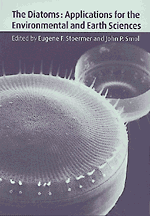Book contents
- Frontmatter
- Contents
- Contributors
- Preface
- Part I Introduction
- Part II Diatoms as indicators of environmental change in flowing waters and lakes
- Part III Diatoms as indicators in extreme environments
- Part IV Diatoms as indicators in marine and estuarine environments
- 13 Diatoms as indicators of coastal paleoenvironments and relative sea-level change
- 14 Diatoms and environmental change in brackish waters
- 15 Applied diatom studies in estuaries and shallow coastal environments
- 16 Estuarine paleoenvironmental reconstructions using diatoms
- 17 Diatoms and marine paleoceanography
- Part V Other applications
- Part VI Conclusions
- Glossary, and acronyms
- Index
16 - Estuarine paleoenvironmental reconstructions using diatoms
Published online by Cambridge University Press: 16 January 2010
- Frontmatter
- Contents
- Contributors
- Preface
- Part I Introduction
- Part II Diatoms as indicators of environmental change in flowing waters and lakes
- Part III Diatoms as indicators in extreme environments
- Part IV Diatoms as indicators in marine and estuarine environments
- 13 Diatoms as indicators of coastal paleoenvironments and relative sea-level change
- 14 Diatoms and environmental change in brackish waters
- 15 Applied diatom studies in estuaries and shallow coastal environments
- 16 Estuarine paleoenvironmental reconstructions using diatoms
- 17 Diatoms and marine paleoceanography
- Part V Other applications
- Part VI Conclusions
- Glossary, and acronyms
- Index
Summary
Introduction
Historically, there has been a lack of appreciation of the severity of human impacts on estuaries, and of how important these systems are to human society. The demand for resources and the products and residues generated as human populations grow will continue to cause cultural, economic, aesthetic and environmental problems, especially in coastal areas. Understanding the processes surrounding these problems is important for managing the continuing impacts of growing populations (National Research Council, 1993). Environmental issues relevant to estuaries include eutrophication, anoxia, harmful algal blooms, industrial pollution, loss of habitats such as wetlands and submerged aquatic vegetation, land-use effects on turbidity and sedimentation, and invasion of exotic species (National Safety Council, 1993).
Paleoecology offers powerful techniques with which to study historical changes due to human influences in depositional environments, including estuaries. A paleoecological approach makes it possible to define the naturally occurring state of an ecosystem, against which human influences can be measured (Smol, 1992). Diatoms are particularly useful not only because they are preserved in the sediment record but because they have a rapid reproductive rate and respond quickly to changes in nutrient availability and other water quality conditions. In addition, diatoms are abundant in aquatic environments, generally cosmopolitan in distribution, and have a fairly well-studied taxonomy and ecology.
Paleoecological studies in estuarine environments have lagged behind paleolimnology, in large part because of the more dynamic nature of coastal ecosystems.
- Type
- Chapter
- Information
- The DiatomsApplications for the Environmental and Earth Sciences, pp. 352 - 373Publisher: Cambridge University PressPrint publication year: 1999
- 17
- Cited by



